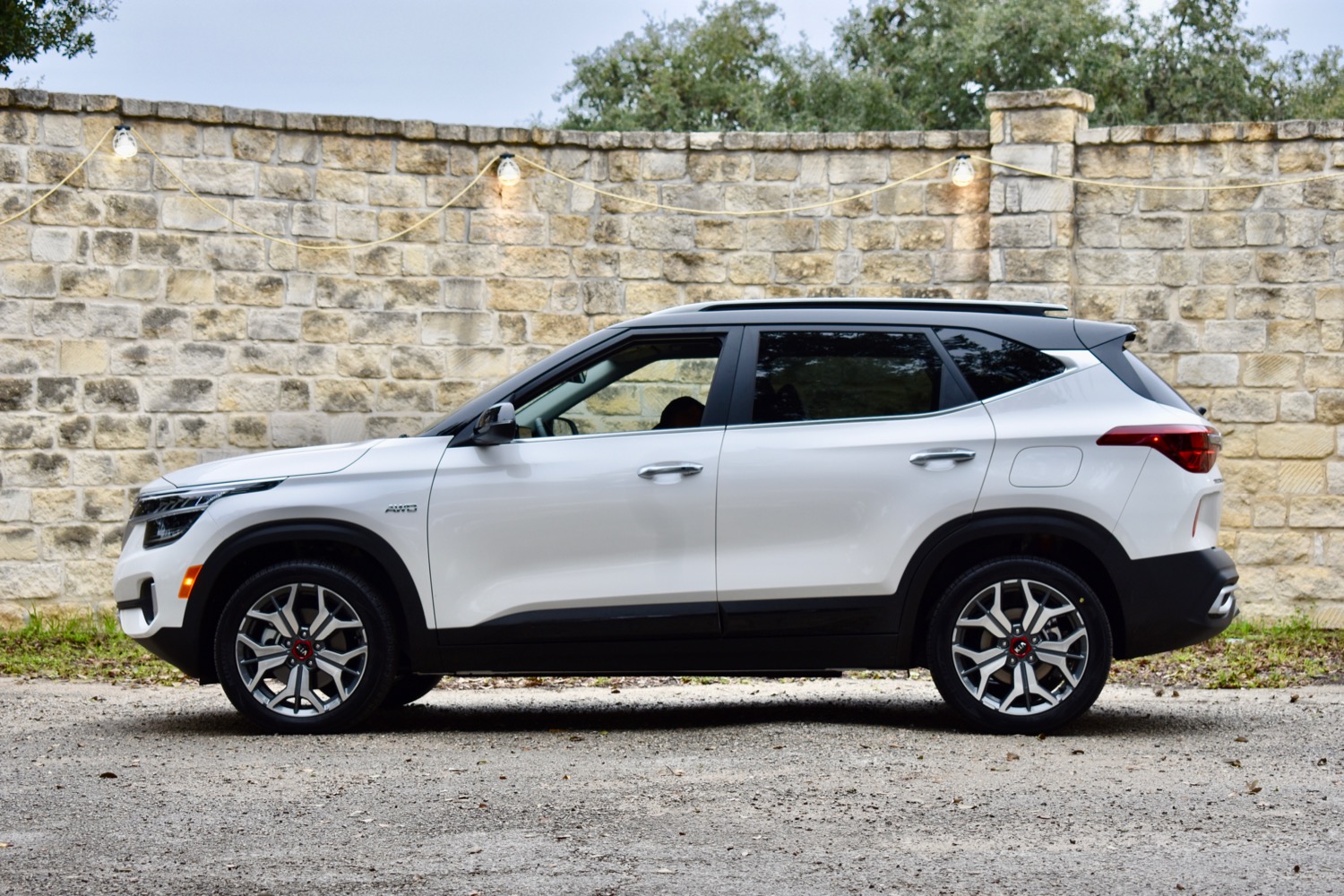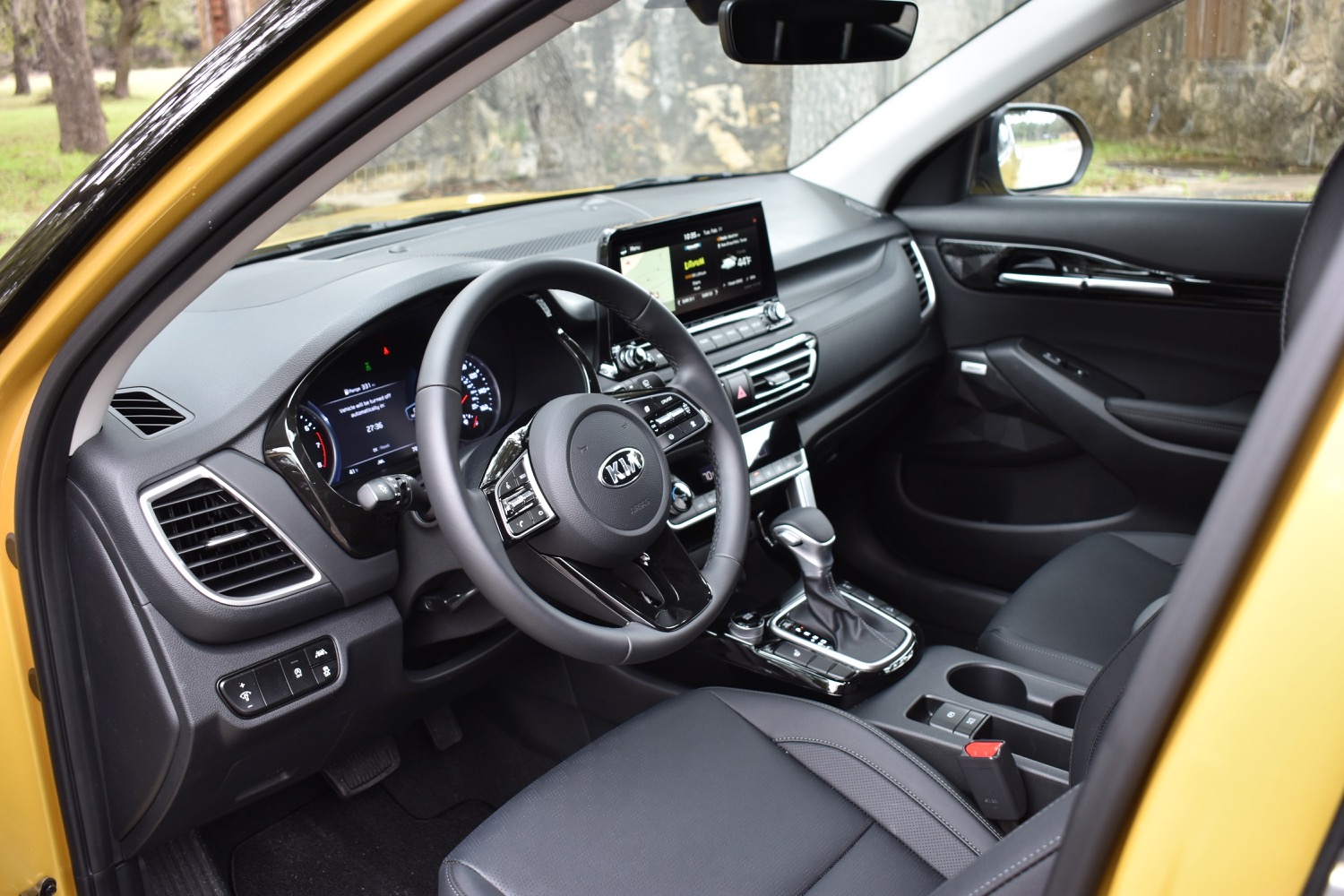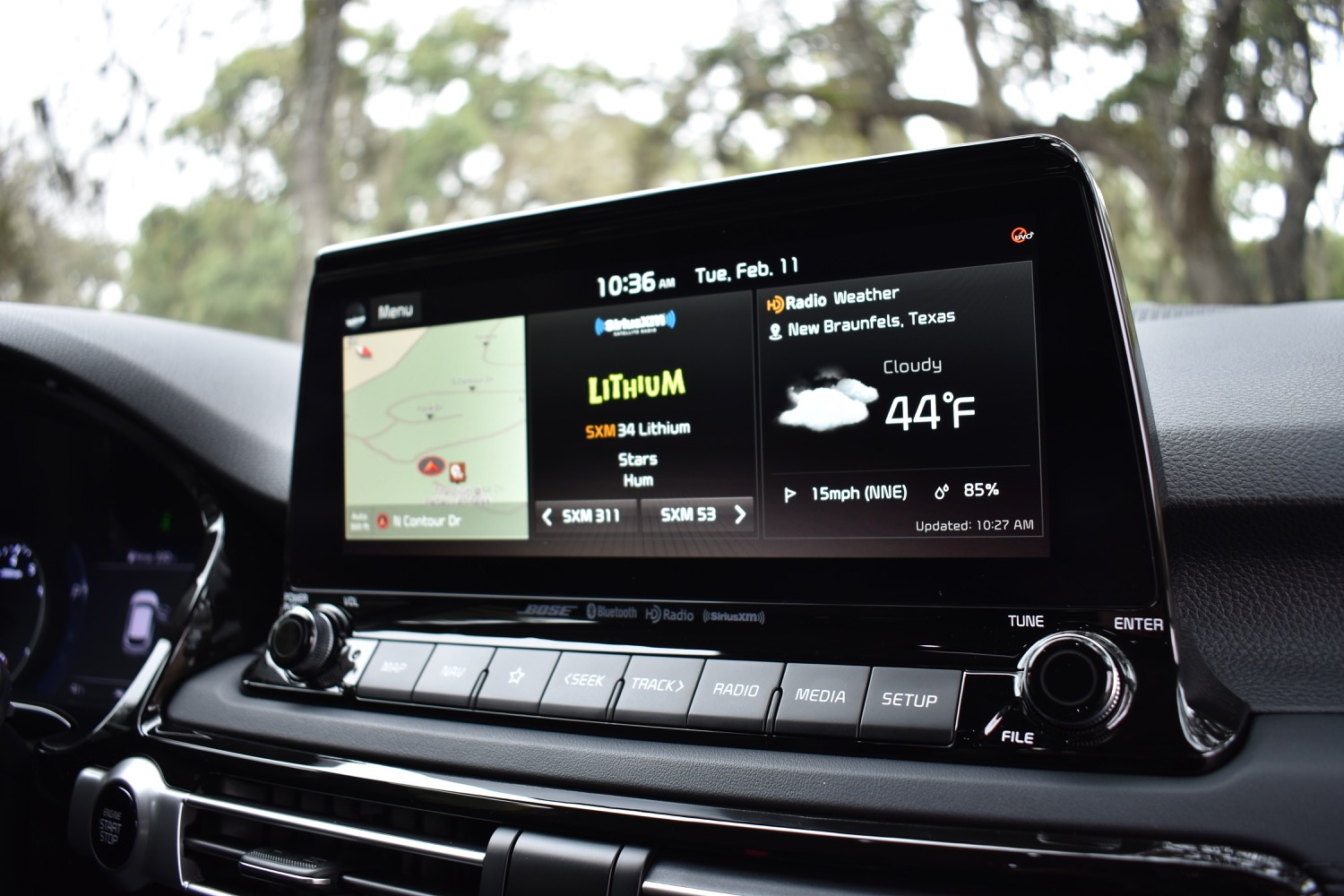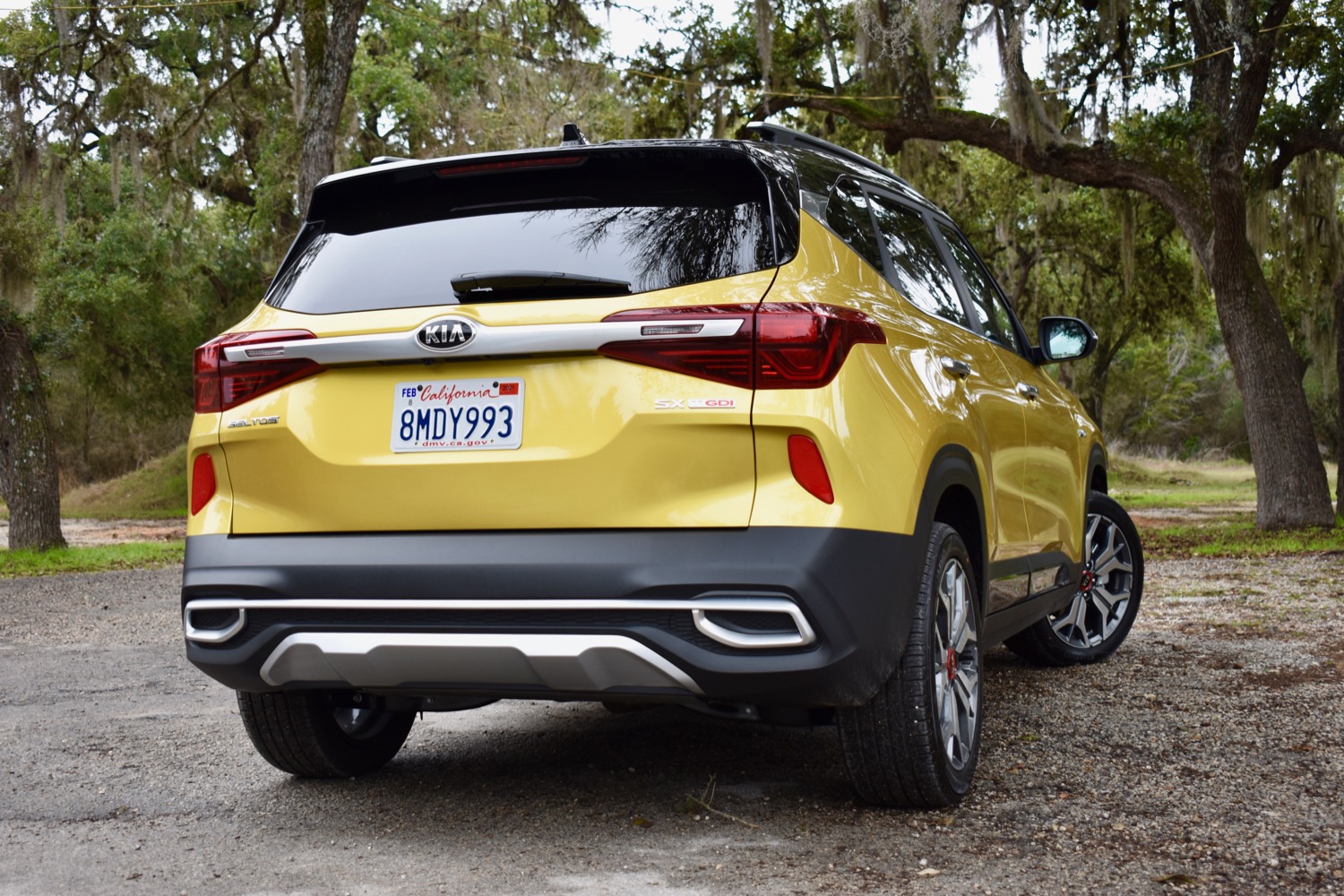“The 2021 Kia Seltos offers practicality and tech in equal measure.”
- Spacious interior
- Capable AWD
- Peppy turbo engine
- Great tech value
- Driver aid controls buried in touchscreen
- Mediocre handling
Variety may be the spice of life, right? But, too much spice can cause heartburn.
At the media drive for the 2021 Seltos, Kia listed no less than 17 vehicles as potential competitors for its new subcompact crossover. That list includes well-regarded models such as the Honda HR-V and Hyundai Kona, the latter from Kia’s parent brand. So, what did Kia do to distinguish the Seltos from this large group of rivals?
Buyers may like to think they’re getting rugged SUVs, but vehicles in this class are essentially hatchbacks on stilts. Still, Kia has made the Seltos as SUV-like as possible, giving it a more sophisticated all-wheel drive system than many rivals. Kia also emphasized value, giving the Seltos a long list of driver aids and tech features.
Kia offers buyers a unique choice. The base price of $23,110 buys either an all-wheel drive LX model, or an S model without all-wheel drive (with more tech features). Kia provided a range-topping all-wheel drive SX model, which starts at $29,010, to test.
Design & Interior
The Seltos shares a basic platform with the Hyundai Kona, but the two crossovers could not be more different when it comes to exterior design. Where the Hyundai is all sci-fi curves, the Kia has a more traditional, squared-off look. It may be engineered more like a subcompact hatchback, but the Seltos looks like an SUV.
It also offers more SUV-like utility than many rivals. The Seltos offers substantially more rear-seat space than its Kona platform mate, as well as more cargo space than any direct competitor. However, the Honda HR-V’s “Magic” rear-seat folding mechanism makes it easier to take advantage of what cargo space is available. The Honda also offers more rear-seat legroom than the Kia, while the Jeep Renegade has more headroom front and rear. Regardless, the Seltos offers enough added utility to justify buying one over a comparably-sized car – which isn’t always the case in this segment.
The Seltos’ interior is also a nice place to be. It’s not exactly fancy, but materials feel appropriate for this price range. The upright roof leaves lots of room for glass, providing good outward visibility and giving the interior an airy feeling. The front seats felt decently comfortable over a day of driving, and the rear seats recline.
Tech, Infotainment, & Driver Assist
The standard infotainment system includes an 8-inch touchscreen with Apple CarPlay and Android Auto. SX models get a 10.25-inch touchscreen, as well as built-in navigation and satellite radio. While the systems have Kia’s Uvo branding, they have the same graphics as the BlueLink systems we’ve seen in recent Hyundai models.
That’s not a bad thing. Typical for Kia (and Hyundai), the infotainment interface is lacking in bells and whistles, but is still easy to use. The one major fault is that Kia forces the driver to dive deep into screen menus to switch driver aids on and off. It’s not exactly easy to do while driving, and we wish Kia included some hard buttons instead.
Speaking of driver aids, the Seltos offers more than its Hyundai Kona sibling. The LX trim level comes standard with autonomous emergency braking (including pedestrian and cyclist detection) and a driver attention monitor. For the same base price, the S trim level adds lane departure warning lane keep assist, and automatic high beams, but you have to sacrifice all-wheel drive to get them.
The infotainment interface is somewhat lacking in bells and whistles, but is still easy to use.
Adaptive cruise control is available, but only on the top SX trim level. That feature isn’t available at all on the Kona, but is available on some competitors, and is standard on the Honda HR-V. The Nissan Rogue Sport is available with the automaker’s ProPilot Assist system, which combines adaptive cruise control with automated lane centering.
The Seltos also features lane follow assist, which adds a bit more functionality to the lane keep assist. Standard on the S trim level, it looks at the center of the lane, rather than the lane markings, to keep the car on the correct path. That means the system proactively steers, rather than waiting for the car to veer out of its lane. You can feel lane follow assist working, almost like another pair of hands are on the steering wheel. However, its inputs are relatively gentle, unlike some of the more basic lane keep assist systems we’ve encountered.
Driving experience
The Seltos comes standard with a 2.0-liter naturally aspirated four-cylinder engine, making 146 horsepower and 132 pound-feet of torque. This engine is mated to a continuously variable transmission (CVT), which Kia calls an Intelligent Variable Transmission (IVT). Our test car had the optional 1.6-liter turbocharged four-cylinder. Turbocharging allows this smaller engine to make 175 hp and 195 lb-ft, and Kia coupled it to a seven-speed dual-clutch transmission for a sportier feel.
The turbocharged powertrain is a winner. The engine offers plenty of grunt, and the dual-clutch transmission’s quick shifts help make the post of it. This is basically the same as used in the Hyundai Kona Ultimate, and it was a standout feature of that car as well.
However, the Kia lacks the Hyundai’s sporty handling. There’s nothing wrong with the way the Seltos handles, but it isn’t as sharp and precise as the Kona. The Seltos does have a more comfortable ride than the Kona, though, and the target buyer is more likely to care about that than corner-carving ability. If you want your small crossover to feel like a sports car, get the Hyundai or, better yet, the Mazda CX-30.
The turbocharged powertrain is a winner.
The Seltos is available with front-wheel drive or all-wheel drive, with the latter offering more capability than many systems in this segment. It allows the driver to manually lock torque in a 50/50 front/rear split, ensuring the car doesn’t default to front-wheel drive. Torque vectoring shunts power side to side to help turn the Seltos into corners. Hill start assist and hill descent control are standard. The all-wheel drive system even has a cool name: Dynamax.
These features should add confidence in bad weather or on unpaved roads, but they don’t turn the Seltos into an off-roader. Kia was quick to point out that the Seltos has a better approach angle than a Jeep Renegade or Subaru Crosstrek, meaning you’re less likely to smash the front end into something while driving over uneven terrain.
But the Seltos has less ground clearance than the Crosstrek or Renegade. Something scraped the bottom of the car on a dirt path that was part of the drive route, so it’s hard to imagine feeling confident driving the Seltos on an actual off-road trail. The Renegade remains the only vehicle in this segment with true off-road capability.
Gas mileage & Safety
Gas-mileage ratings for the 2.0-liter/CVT combination are 31 mpg combined (29 mpg city, 34 mpg highway) with front-wheel drive, and 29 mpg combined (27 mpg city, 31 mpg highway) with all-wheel drive. The 1.6-liter turbo engine and dual-clutch transmission are only available with all-wheel drive, and are rated at 27 mpg combined (25 mpg city, 30 mpg highway).
Gas mileage is fairly competitive with other vehicles in this segment, to not mention some conventional cars. Less-aerodynamic bodywork and added weight usually bring a gas-mileage penalty to crossovers, but it’s not very severe with this one.
The Seltos delivers on the things that distinguish crossovers from ordinary cars.
The Seltos is a new model, so it’s difficult to predict future reliability. Kia has a fairly good overall reputation for reliability, however, and offers generous warranty coverage. Kia’s 10-year, 100,000-mile, powertrain warranty and five-year, 60,000-mile, limited warranty are matched only by corporate parent Hyundai.
Crash test ratings from the National Highway Traffic Safety Administration (NHTSA) and Insurance Institute for Highway Safety (IIHS) are not available at this time.
How DT would configure this car
The SX trim level seems like the best option. Not only does it get the peppier turbocharged engine and quick-shifting dual-clutch transmission, but it’s also the only Seltos trim level with adaptive cruise control. Because the SX is the top trim level, it also incorporates the tech features from lower trims as well, such as autonomous emergency braking, lane keep assist, and wireless phone charging. Even with a base price about $6,000 higher than the cheapest Seltos, the long list of features in the SX makes it a good value.
Our Take
Many crossovers in this price range claim to offer SUV ruggedness, but are really just glorified hatchbacks. The 2021 Kia Seltos is the real deal.
The Seltos delivers on the things that distinguish crossovers from ordinary cars. It offers impressive cargo space for a vehicle of this size, and an all-wheel drive system that will make a real difference in foul weather. This contrasts the Seltos’ platform mate, the Hyundai Kona. While the Kona is a good vehicle, its lack of cargo space and car-like demeanor make it harder to justify buying one instead of a conventional hatchback.
In such a crowded field, competitors inevitably do certain things better than the Seltos. The Kia lacks the off-road capability of the Jeep Renegade, or the on-road poise of the Mazda CX-30. While Seltos is available with many driver aids, the Honda HR-V offers more of them as standard equipment. But while it may not be the best in some areas, the Seltos does everything well.
Should you get one?
Yes. The Seltos is an impressive value.







